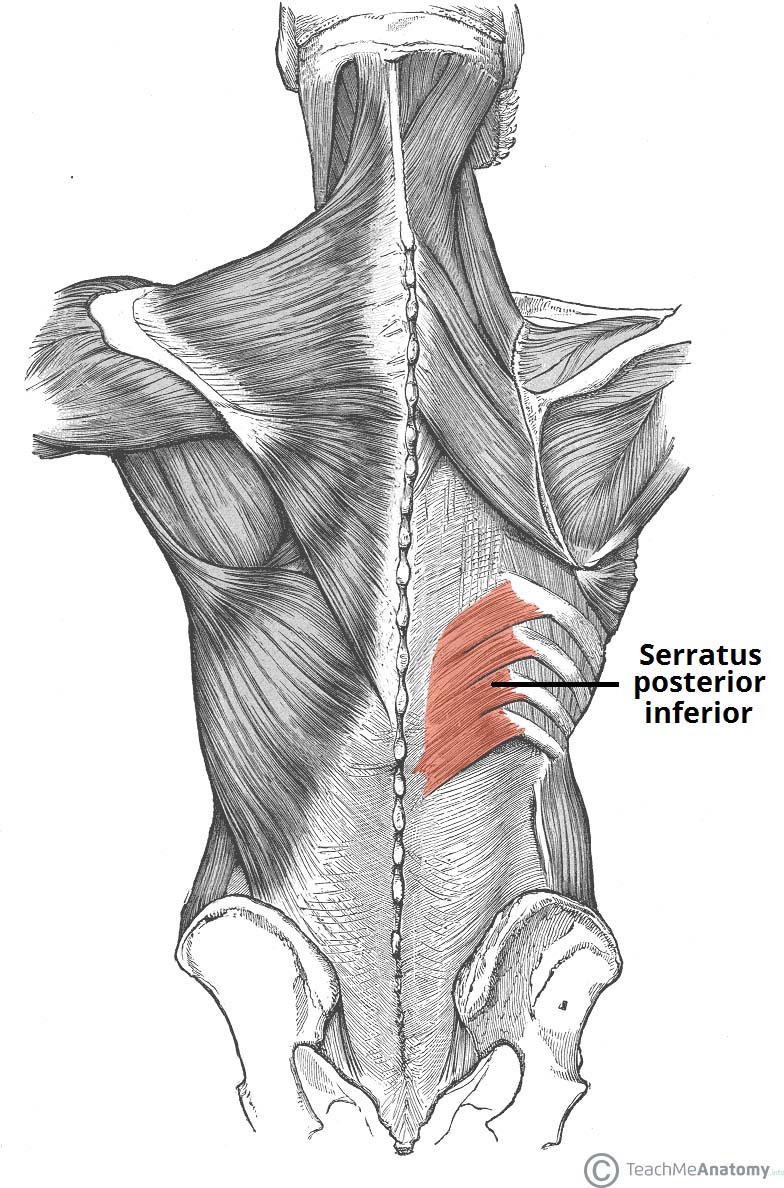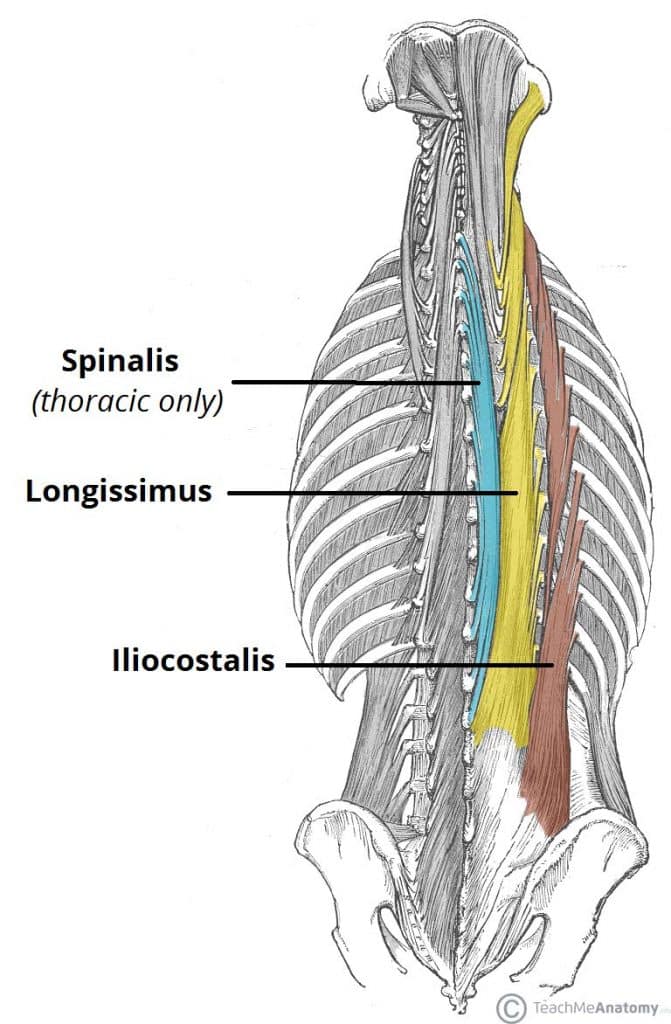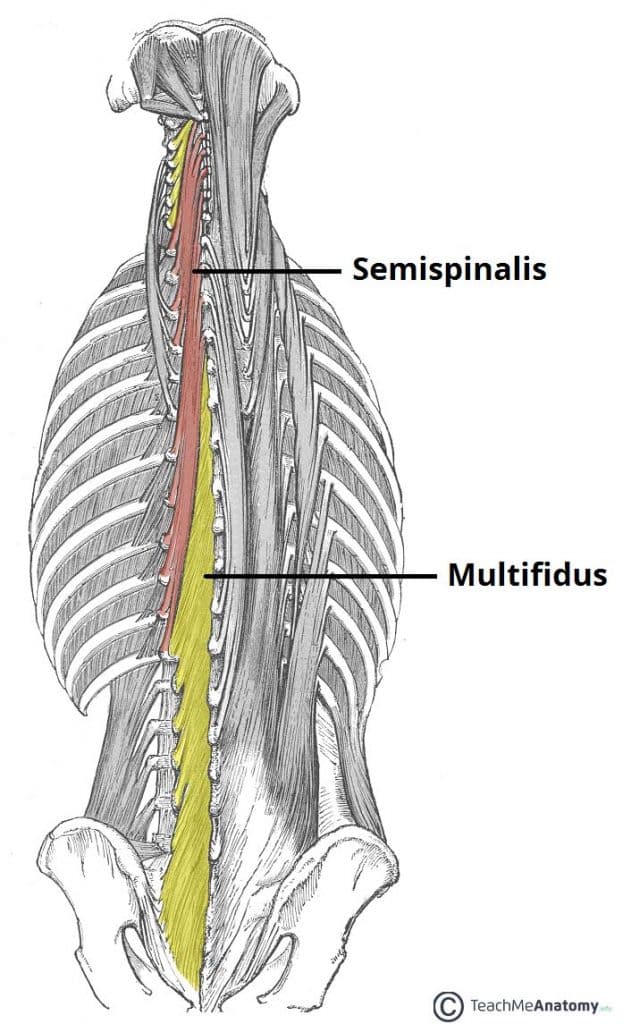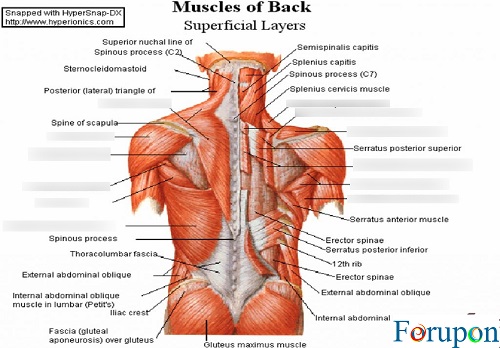The Superficial Back Muscles
The muscles of the back can be divided into three groups – superficial, intermediate, and intrinsic:
- Superficial – associated with movements of the shoulder.
- Intermediate – associated with movements of the thoracic cage.
- Deep – associated with movements of the vertebral column.
The deep muscles develop embryologically in the back and are thus described as intrinsic muscles. The superficial and intermediate muscles do not develop in the back and are classified as extrinsic muscles.
This article is about the anatomy of the intermediate back muscles – their attachments, innervations, and functions.
The intermediate group contains two muscles – the serratus posterior superior and the serratus posterior inferior. These muscles run from the vertebral column to the ribcage and assist with elevating and depressing the ribs. They are thought to have a slight respiratory function.

Fig 1.0 – The serratus posterior inferior.
Serratus Posterior Superior
The serratus posterior superior is a thin, rectangular-shaped muscle. It lies deep in the rhomboid muscles on the upper back.
- Attachments: Originates from the lower part of the ligament nuchae, and the cervical and thoracic spines (usually C7 – T3). The fibers pass in an inferolateral direction, attaching to ribs 2-5.
- Innervation: Intercostal nerves.
- Actions: Elevates ribs 2-5.
Serratus Posterior Inferior
The serratus posterior inferior is broad and strong. It lies underneath the latissimus dorsi.
- Attachments: Originates from the thoracic and lumbar spines (usually T11 – L3). The fibers pass in a superolateral direction, attaching to ribs 9-12.
- Innervation: Intercostal nerves.
- Actions: Depresses ribs 9-12.
The article was originally published here.
The Intrinsic Back Muscles
The muscles of the back can be divided into three groups – superficial, intermediate, and intrinsic:
- Superficial – associated with movements of the shoulder.
- Intermediate – associated with movements of the thoracic cage.
- Deep – associated with movements of the vertebral column.
The deep muscles develop embryologically in the back and are thus described as intrinsic muscles. The superficial and intermediate muscles do not develop in the back and are classified as extrinsic muscles.
This article is about the anatomy of the deep (intrinsic) back muscles – their attachments, innervations, and functions.
The deep muscles of the back are well-developed and collectively extend from the sacrum to the base of the skull. They are associated with the movements of the vertebral column and the control of posture.
The muscles themselves are covered by deep fascia, which plays a key role in their organization.
Anatomically, the deep back muscle’s can be divided into three layers; superficial, intermediate, and deep. We shall now look at each layer in more detail.
Superficial
The superficial muscles are also known as the Spinotransversales. There are two muscles in this group – splenius Capitis and splenius Cervicis. They are both associated with movements of the head and neck.
They are located on the posterolateral aspect of the neck, covering the deeper neck muscles.
Splenius Capitis
- Attachments: Originates from the lower aspect of the ligament nuchae, and the spinous processes of C7 – T3/4 vertebrae. The fibers ascend, attaching to the mastoid process and the occipital bone of the skull.
- Innervation: Posterior rami of spinal nerves C3 and C4.
- Actions: Rotate the head to the same side.
Splenius Services
- Attachments: Originates from the spinous processes of T3-T6 vertebrae. The fibers ascend, attaching to the transverse processes of C1-3/4.
- Innervation: Posterior rami of the lower cervical spinal nerves.
- Actions: Rotate the head to the same side.
Note: The two splenius muscles can also act together to extend the head and neck.

Fig 1.0 – The splenius muscles, located with the superficial layer of intrinsic back muscle’s.
Intermediate
There are three intermediate intrinsic back muscle’s – the iliocostalis, longissimus, and Spinalis. Together these muscles form a column, known as the erector spine.
The erector Spinae is situated posterolaterally to the spinal column, between the vertebral spinous processes and the costal angle of the ribs.
All three muscles can be subdivided by their superior attachments (into lumbar, thoracic, cervical, and capital). They also all have a common tendinous origin, which arises from:
- Lumbar and lower thoracic vertebrae.
- Sacrum.
- Posterior aspect of the iliac crest.
- Sacroiliac and supraspinous ligaments.
Iliocostalis

Fig 1.1 – The erector Spinae.
The iliocostalis muscle is located laterally within the erector Spinae. It is associated with the ribs and can be divided into three parts – Lumborum, thoracic, and cervical.
- Attachments: Arises from the common tendinous origin, and attaches to the costal angle of the ribs and the cervical transverse processes.
- Innervation: Posterior rami of the spinal nerves.
- Actions: Acts unilaterally to laterally flex the vertebral column. Acts bilaterally to extend the vertebral column and head.
Longissimus
The longissimus muscle is situated between the iliocostalis and Spinalis. It is the largest of the three columns. It can be divided into three parts – thoracic, Cervicis, and Capitis.
- Attachments: Arises from the common tendinous origin, and attaches to the lower ribs, the transverse processes of C2 – T12, and the mastoid process of the skull.
- Innervation: Posterior rami of the spinal nerves.
- Actions: Acts unilaterally to laterally flex the vertebral column. Acts bilaterally to extend the vertebral column and head.
Spinalis
The Spinalis muscle is located medially within the erector Spinae. It is the smallest of the three muscle columns. It can be divided into thoracic, cervical, and Capitis (although the Cervicis part is absent in some individuals).
- Attachments: Arises from the common tendinous origin, and attaches to the spinous processes of C2, T1-T8, and the occipital bone of the skull.
- Innervation: Posterior rami of the spinal nerves.
- Actions: Acts unilaterally to laterally flex the vertebral column. Acts bilaterally to extend the vertebral column and head.
Deep
The deep intrinsic muscles are located underneath the erector Spinae and are known collectively as the Transversospinales. They are a group of short muscles, associated with the transverse and spinous processes of the vertebral column.
There are three major muscles in this group – the semispinalis, multifidus, and rotatores.
Semispinalis

Fig 1.2 – The semispinalis and multifidus muscles.
The semispinalis is the most superficial of the deep intrinsic muscles. Much like the intermediate muscles, it can be divided by its superior attachments into thoracic, Cervicis, and Capitis.
- Attachments: Originates from the transverse processes of C4-T10. The fibers ascend 4-6 vertebral segments, attaching to the spinous processes of C2-T4, and to the occipital bone of the skull.
- Innervation: Posterior rami of the spinal nerves.
- Actions: Extends and contralaterally rotates the head and vertebral column.
Multifidus
The multifidus is located underneath the semispinalis muscle. It is best developed in the lumbar area.
- Attachments: Has a broad origin – arises from the sacrum, posterior iliac spine, the common tendinous origin of the erector Spinae, mamillary processes of lumbar vertebrae, transverse processes of T1-T3 and articular processes of C4-C7. The fibers ascend 2-4 vertebral segments, attaching the spinous processes of the vertebrae.
- Innervation: Posterior rami of the spinal nerves.
- Actions: Stabilises the vertebral column.
Rotatores
The rotatores are most prominent in the thoracic region
- Attachments: Originates from the vertebral transverse processes. The fibers ascend and attach to the lamina and spinous processes of the immediately superior vertebrae.
- Innervation: Posterior rami of the spinal nerves.
- Actions: Stabilises the vertebral column, and has a proprioceptive function.
Minor Deep Intrinsic Muscles:
- Interspinal: Spans between adjacent spinous processes. Acts to stabilize the vertebral column.
- Intertranversari – Spans between adjacent transverse processes. Acts to stabilize the vertebral column.
- Lavatories Costarum – Originates from the transverse processes of C7-T11, and attaches to the rib immediately below. Acts to elevate the ribs.
The article was originally published here.
The Intermediate Back Muscles
The muscles of the back can be divided into three groups – superficial, intermediate, and intrinsic:
- Superficial – associated with movements of the shoulder.
- Intermediate – associated with movements of the thoracic cage.
- Deep – associated with movements of the vertebral column.
The deep muscles develop embryologically in the back and are thus described as intrinsic muscles. The superficial and intermediate muscles do not develop in the back and are classified as extrinsic muscles.
This article is about the anatomy of the intermediate back muscle’s – their attachments, innervations, and functions.
The intermediate group contains two muscles – the serratus posterior superior and the serratus posterior inferior. These muscles run from the vertebral column to the ribcage and assist with elevating and depressing the ribs. They are thought to have a slight respiratory function.

Fig 1.0 – The serratus posterior inferior.
Serratus Posterior Superior
The serratus posterior superior is a thin, rectangular-shaped muscle. It lies deep in the rhomboid muscles on the upper back.
- Attachments: Originates from the lower part of the ligament nuchae, and the cervical and thoracic spines (usually C7 – T3). The fibers pass in an inferolateral direction, attaching to ribs 2-5.
- Innervation: Intercostal nerves.
- Actions: Elevates ribs 2-5.
Serratus Posterior Inferior
The serratus posterior inferior is broad and strong. It lies underneath the latissimus dorsi.
- Attachments: Originates from the thoracic and lumbar spines (usually T11 – L3). The fibers pass in a superolateral direction, attaching to ribs 9-12.
- Innervation: Intercostal nerves.
- Actions: Depresses ribs 9-12.
The article was originally published here.


Comments are closed.